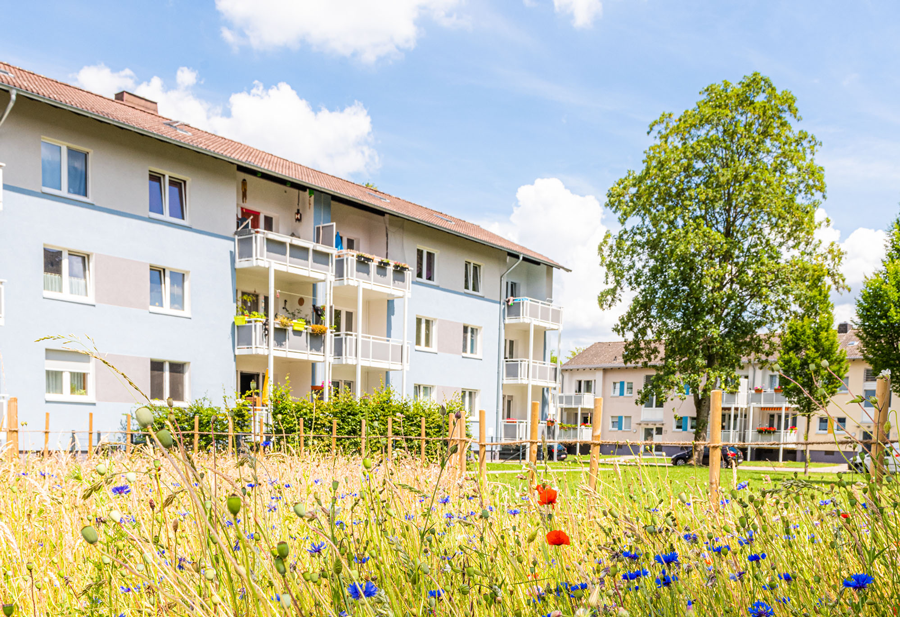Dear Readers,
GRI
102-14
When the chips are down, people band together. No questions asked. Even when it comes at a cost. That is what we have seen over the last two years during the pandemic. We are seeing this principle in action once again as thousands of people, displaced by the military conflict between Russia and Ukraine, are coming to Germany. Most of them are women and children looking for safety in central Europe.
Vonovia is cutting through all the red tape that it can in order to provide them with housing – even though that is no substitute for the familiar world they have left behind. It also probably won’t do anything to ease their worries about their friends and family who are still in Ukraine. Nevertheless, gestures like these can, at the very least, provide some kind of respite. It is also evidence of people’s willingness to stand together, regardless of borders.
We will need to come together in a similar way if we are to find solutions to the big issues that society is currently facing. From climate change through to demographic trends, urbanization and growing inequality – our society, and by extension our policymakers and cities, will only be able to overcome these challenges by pulling together and working with large residential real estate companies.
But how do we fit into this picture? I am convinced that solving the issues at hand isn’t about individual buildings. It’s about neighborhoods. Neighborhoods define the quality of life of their residents. They let us cultivate the diversity that we need. And a neighborhood approach is the only way for us to improve the energy efficiency of our portfolios – a key part of the energy transition – in a way that is financially viable for both tenants and landlords.
We are aiming for our portfolio to be virtually climate neutral by 2045. This simply won’t be possible unless we take a neighborhood-based approach. Realistically, insulating buildings won’t be enough to achieve climate neutrality; we need to take a new integrated approach that brings energy, heat and mobility together.
Our neighborhoods are the power plants of the future. That’s why we are setting up rooftop systems that generate green energy for our tenants to use. We are looking at the possibility of switching to eco-friendly hydrogen for our electricity and heating needs. Pilot projects in Bochum-Weitmar are helping us to draw up plans for a decentralized energy supply, where energy is generated, stored and consumed within the neighborhood – either by residential units or at charging stations. This approach is becoming increasingly relevant for our customers with energy prices on the rise.
There’s no time to waste if we are going to get a handle on the climate crisis. That’s why we are accelerating our projects; we want to have photovoltaic systems installed on 17,000 roofs by 2030. These will generate 194 million kWh per year, cutting emissions by 133,000 t CO2. We intend to install a photovoltaic system on every suitable roof in our portfolio by 2050.
We will also be reducing our carbon emissions significantly by using different building materials. We built 700 modular wooden homes extremely quickly in the Reinickendorf district of Berlin last year, showing that it is possible for large construction projects to be sustainable.
We launched the Energiesprong project in Bochum at the end of last year. This sustainable serial refurbishment process prefabricates parts used for facade insulation to the exact millimeter. All of the construction materials used are sustainable, and some of them are recycled. The project is powered by solar panels and geothermal energy. Buildings refurbished using the Energiesprong process generate just as much energy as they consume each year. This is where we need to get to, along with the rest of the housing industry.
This fall we will be running a conference all about building materials to give representatives across the industry a chance to come together – much as we did with our 2020 climate conference. Experts from the housing industry and the construction and construction materials sector will meet with representatives from associations and the worlds of science and politics to discuss sustainability, recycling and the affordability of construction materials.
Dear reader, I hope it’s clear that we take our social and environmental responsibilities seriously – just as seriously as we take our responsibility for our customers. All of the steps we are taking come back to the heart of what drives us as a company: providing affordable housing where people can feel at home.
We have ramped up the intensity of our sustainability efforts over the last two years. The progress we have made is reflected in our improved Sustainability Performance Index (SPI). At 109%, our key non-financial indicator was four percentage points higher than we expected. This improvement was mainly driven by our German portfolio’s carbon intensity going down from 39.5 in 2020 to 38.4 kg CO2e/m². This figure came to around 56 kg CO2e/m² in 2014. We have definitely made progress, but there’s even more to come.
Thank you for your interest in everything we are doing as a company in the interest of sustainability. Keep reading to find out more about our progress and future plans in our seven action areas. Please get in touch if you have any questions. Our sustainability team is looking forward to hearing from you!
Bochum, April 2022
Rolf Buch


